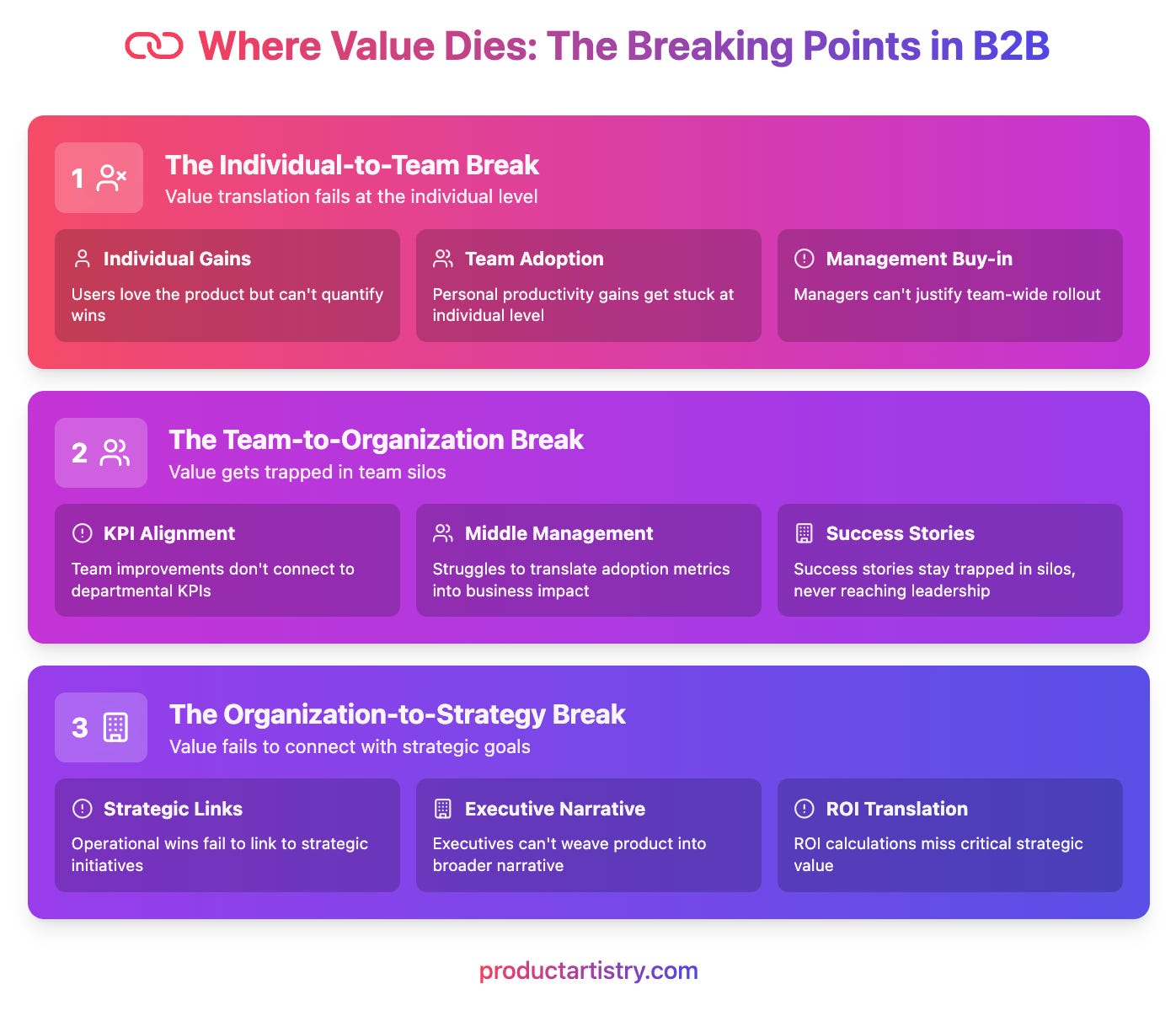Why B2B Products Fail Without Mastering Value Translation
Master Value Translation to Win Across Every Audience
The Insight That Changed Everything
Early in my product career, I experienced something that fundamentally changed how I think about B2B products.
I was running demos constantly—different companies, different stakeholders, different priorities.
Young and eager, I believed I had a winning product. But what amazed me wasn’t just how diverse these organizations were—it was how differently each audience saw the product’s value:
To users, it was an immediate win: "Wow, I can pull these insights for my presentations in seconds!"
To managers, it triggered a broader calculation: "How can this help us streamline operations across the team?"
To C-suite executives, it barely registered—until one key metric appeared: "Hold on, go back to that trend-line."
It became clear to me: B2B success isn’t about features—it’s about translating value effectively across layers of the organization.
I realized something crucial: I wasn’t just seeing different interpretations of the same value. I was watching value transform—or die—as it moved through organizational layers.
Each stakeholder didn’t just see different benefits—they needed entirely different stories to fight their own battles.
This pattern isn’t unique to my experience—it’s everywhere in B2B. And yet, most product teams miss it entirely.
The Value Translation Chain
If you’ve ever watched an enterprise deal stall, you know the frustration. On the surface, the reasons often sound simple:
"They chose another vendor."
"The budget got cut."
At first glance, these explanations might seem like the end of the story. But in my experience, they’re not the real reasons deals fall apart. They’re symptoms of a deeper failure: broken value translation.
What is value translation?
In B2B, the journey of your product’s value doesn’t stop with the first person who sees it. It needs to travel—across teams, up the chain of command, and into the hands of decision-makers. At every stage, your product’s value is reshaped and reinterpreted.
If this chain breaks at any point, deals stall, champions lose momentum, and your product’s story dies in the process.
The Role of Client-Side Champions
Your client-side champions—the people inside customer organizations who believe in your product—are your most critical allies. They are the ones who:
For users: Share quick wins and advocate for the product.
For managers: Build the case for broader adoption.
For executives: Connect your product to big-picture goals.
Champions aren’t just "nice to have"—they’re essential. Yet most products don’t empower them with the right stories to succeed.
Here’s what really happens:
Your client-side champions lose internal battles they shouldn’t have lost. Not because your product wasn’t good enough, but because they didn’t have the right narrative ammunition to fight for it in their organization.
Where Value Dies: The Breaking Points
In B2B, value dies at predictable breaking points—each tied to the organizational layers your product must pass through:
1. The Individual-to-Team Break
Users love the product but can’t quantify their wins.
They may find it personally helpful, but without measurable outcomes, their enthusiasm doesn’t translate into broader adoption.Personal productivity gains get stuck at the individual level.
Insights or efficiency improvements stay limited to single users, making it hard to show value at scale.Managers can’t justify a team-wide rollout based on isolated success stories.
Without aggregated data or success metrics, managers lack the evidence they need to advocate for adoption across their teams.
2. The Team-to-Organization Break
Team improvements don’t connect to departmental KPIs.
Even if a team benefits from the product, those wins can feel disconnected from higher-level goals, making them less compelling.Middle management struggles to translate adoption metrics into business impact.
Without clear alignment to broader objectives, adoption rates and usage stats may fail to resonate with leadership.Success stories stay trapped in silos, never reaching leadership.
Wins at the team level often fail to make their way up the chain, stalling the narrative before it can gain executive buy-in.
3. The Organization-to-Strategy Break
Operational wins fail to link to strategic initiatives.
Day-to-day improvements may seem too tactical if they’re not explicitly tied to high-level goals like growth, innovation, or compliance.Executives can’t weave the product into the company’s broader narrative.
Without a clear strategic fit, the product risks being seen as a "nice-to-have" rather than a critical tool for achieving the company’s vision.ROI calculations miss critical strategic value angles.
Numbers may fail to capture long-term or intangible benefits, making the case for investment less compelling at the highest levels.
Why Ugly Products Win
Seemingly "ugly" products often dominate the B2B market. They’re not winning despite their flaws—they’re winning because they’ve mastered value translation.
These products may have:
A clunky UI that frustrates users.
Features that lag behind competitors.
Outdated technical architecture that developers dislike.
Yet, they win. Again and again.
Why? Because they understand something crucial:
In B2B, success isn’t just about what your product does—it’s about how it helps people prove their success to others.
For Users: Not just "This makes me more effective" but "Here’s how I can prove my impact."
For Managers: Not just "This makes my team more efficient" but "Here’s how I demonstrate organizational value."
For Executives: Not just "This advances our strategic goals" but "Here’s how we showcase market leadership."
Building Translation Engines
Understanding the Value Translation Chain changes everything about how we build B2B products. It’s not enough to solve user problems—you need to design features that cascade value upward, connecting users to managers, and managers to executives.
Here’s how to embed these "translation engines" into your product's core:
1. Design for Multi-Level Impact
Don’t just build features. Build narrative enablers that resonate at every level of the organization by addressing specific needs and priorities:
For Users: Surface insights that make their tasks easier and faster.
Example: "You identified key trends in half the time."
This gives users a clear, personal win, boosting their confidence and productivity by saving effort and time.
For Managers: Aggregate individual insights into team-level reports.
Example: "Your team uncovered 15 actionable trends this month, driving key decisions faster."
Tangible results like these help managers advocate for broader adoption by showcasing measurable team impact.
For Executives: Tie those insights to strategic initiatives.
Example: "Our compliance trend monitoring helped avoid regulatory risks, aligning with strategic goals for Q3."
By framing outcomes in terms of risk mitigation and strategic alignment, you position your product as essential to the company’s success.
The key is making value translation automatic, not an afterthought. By embedding these narratives into your product, you empower champions at every level to articulate its value effectively.
2. Master the Value Cascade
Every feature should tell a connected story—one that scales seamlessly across organizational levels. Design features with flexibility so the same core data can be reframed for the unique perspectives of users, managers, and executives:
User Story: Speaks directly to the user’s need for speed and clarity in daily tasks.
Example: "I used this tool to identify the top compliance risks in seconds."
In a conversation with their manager, a compliance analyst highlights how the tool saves hours, turning a personal win into a team productivity boost.
Manager Translation: Shows how individual actions scale into measurable team-wide improvements.
Example: "My team streamlined risk identification and reduced reporting delays by 50%."
The team lead demonstrates how automation has improved overall efficiency, enabling faster reporting to stakeholders.
Executive Translation: Focuses on strategic outcomes that tie directly to KPIs and long-term goals.
Example: "We’ve enhanced compliance monitoring, avoiding potential penalties and building stakeholder trust."
The compliance officer shares these results with the board, showing how the tool mitigated legal risks and saved the company millions.
The same insight, tailored to different organizational lenses, creates a consistent yet flexible narrative that resonates at all levels. Your goal is to ensure each audience gets the version of the story they need to succeed.
3. Build Narrative Infrastructure
Success in B2B requires more than just features—it requires tools that actively tell your product’s story for you. Embed mechanisms into your product that enable champions at every level to communicate value effortlessly:
Automated value capture at the user level: Automatically track and highlight user achievements, such as time saved, tasks completed, or insights delivered. These metrics make it easy for users to showcase their impact.
Built-in translation mechanisms for middle management: Provide dashboards or reports that consolidate individual contributions into team-level insights, showing trends, impact metrics, and areas of improvement.
Strategic dashboards for executives: Offer high-level summaries that tie performance metrics directly to strategic priorities like revenue growth, compliance, or competitive positioning.
Think of your product as a story-building platform:
Users get tools to document their findings and communicate their wins.
Managers receive synthesized insights to advocate for broader adoption.
Executives gain strategic narratives that demonstrate measurable business impact, ensuring your product aligns with their vision.
By embedding narrative infrastructure, you make value translation seamless and scalable, empowering every champion to succeed without relying on external resources.
Silent Success is Still Failure
The harsh truth: In B2B, silent success is still failure. Your product needs to actively enable its story to be told—and retold—at every organizational level.
→ The best features aren’t just powerful. They’re self-narrating.
The Bottom Line
Great features without great stories die in procurement. But average features with powerful narrative chains? They become enterprise standards.
Your job isn’t just to build the best product—it’s to build the product that helps your champions win their internal battles.
When planning features, ask yourself:
How can we empower champions, not just improve features?
How can we create stories that resonate organizationally, not just with users?
How can we ensure product-narrative fit, not just product-market fit?
You’re not just building software. You’re creating the stories, tools, and resources your champions need to advocate for your product—and succeed at every level.
→ Make sure your champions have everything they need to win.
Thanks for reading!—Found value in this? Three ways to help:
Like, Comment, and Share—Help increase the reach of these ideas
Subscribe for free—Join our community of makers
Become a paid subscriber—Support this creative journey
Keep Iterating,
—Rohan






Storytelling isn’t fluff—it’s strategy.
The article points out that value isn’t static—it’s contextual. The same feature can be a time saver for a user, a team efficiency enabler for a manager, and a strategic asset for an executive, depending on how it’s framed. Always a winner Rohan. Thank you.
You have many great points in this article about the multi-level challenges of value translation in B2B products.
Have you considered how to apply this to a B2B newsletter? Maybe some of these techniques could apply!